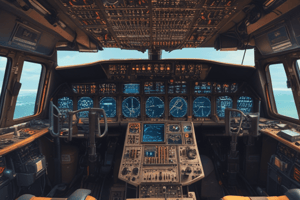Podcast
Questions and Answers
What is the purpose of the ARINC 429 link between CMC 1 and CMC 2?
What is the purpose of the ARINC 429 link between CMC 1 and CMC 2?
- To display warnings and system information
- To enable cross-talk and exchange general data (correct)
- To monitor operational data
- To classify system failures
What happens to warnings on the ECAM display?
What happens to warnings on the ECAM display?
- They are cancelled at the end of the flight
- They are displayed until manually cancelled
- They are displayed until the end of the flight unless cancelled (correct)
- They are never cancelled
Where are fault codes and messages stored?
Where are fault codes and messages stored?
- On the MCDU
- In a non-volatile memory system (correct)
- On the ECAM display
- In a volatile memory system
What type of failures are displayed as warnings in real-time on the ECAM?
What type of failures are displayed as warnings in real-time on the ECAM?
What is the purpose of the flight warning computers?
What is the purpose of the flight warning computers?
What happens if CMC 1 faults or is manually switched?
What happens if CMC 1 faults or is manually switched?
What is the consequence of a Class 2 failure for the current flight?
What is the consequence of a Class 2 failure for the current flight?
What type of failure has no operational or safety consequences for the aircraft?
What type of failure has no operational or safety consequences for the aircraft?
How are Type 1 system computers connected to the CMC?
How are Type 1 system computers connected to the CMC?
What is the purpose of a discrete input in Type 2 systems?
What is the purpose of a discrete input in Type 2 systems?
What is the output connection of Type 2 systems?
What is the output connection of Type 2 systems?
How many flights can Type 1 systems memorise failures for?
How many flights can Type 1 systems memorise failures for?
What is displayed on the data loader LCD during transfer?
What is displayed on the data loader LCD during transfer?
What type of storage media was commonly used in older data loaders?
What type of storage media was commonly used in older data loaders?
What is used to load Field Loadable Software (FLS) into the target hardware?
What is used to load Field Loadable Software (FLS) into the target hardware?
What should be done after loading a Loadable Software Aircraft Part (LSAP)?
What should be done after loading a Loadable Software Aircraft Part (LSAP)?
Where should a copy of the loading record be kept?
Where should a copy of the loading record be kept?
Who must issue a Certificate of Release to Service after loading a Loadable Software Aircraft Part (LSAP)?
Who must issue a Certificate of Release to Service after loading a Loadable Software Aircraft Part (LSAP)?
What is essential for operators to have in place for their aircraft fleet?
What is essential for operators to have in place for their aircraft fleet?
What is the main purpose of a Digital Electronic Library System (DELS)?
What is the main purpose of a Digital Electronic Library System (DELS)?
What replaced most of the normal cockpit paperwork?
What replaced most of the normal cockpit paperwork?
What is an example of the information provided by a Digital Electronic Library System?
What is an example of the information provided by a Digital Electronic Library System?
What is a benefit of a Digital Electronic Library System in the case of an engine emergency?
What is a benefit of a Digital Electronic Library System in the case of an engine emergency?
What is a Digital Electronic Library System typically interfaced with?
What is a Digital Electronic Library System typically interfaced with?
What is the primary purpose of Electronic Flight Bags (EFBs)?
What is the primary purpose of Electronic Flight Bags (EFBs)?
Where are Electronic Flight Bag displays usually installed?
Where are Electronic Flight Bag displays usually installed?
According to the Civil Aviation Authorities, how many classes of EFB hardware are defined?
According to the Civil Aviation Authorities, how many classes of EFB hardware are defined?
What is characteristic of Class 1 EFB systems?
What is characteristic of Class 1 EFB systems?
What is a key difference between Class 1 and Class 2 EFB systems?
What is a key difference between Class 1 and Class 2 EFB systems?
What is possible with Class 2 EFB systems?
What is possible with Class 2 EFB systems?
Flashcards are hidden until you start studying
Study Notes
Electronic Flight Bag (EFB)
- EFBs replace traditional reference materials like books and charts on flight decks.
- They are typically displayed on additional cockpit panel units.
- Civil Aviation Authorities define three classes of EFB hardware.
Class 1 EFB
- Class 1 EFBs are portable, Commercial Off-the-Shelf (COTS) systems for aircraft operations.
- They connect to aircraft power through a certified source but are not mounted in the cockpit.
- No prior administrative control is needed for use.
- Considered Portable Electronic Devices (PEDs).
Class 2 EFB
- Class 2 EFBs are also portable and COTS-based, meant for aircraft operations.
- They require mounting in the cockpit and airworthiness approval before usage.
- Connectivity to avionics is enabled.
- Can interface with Central Maintenance Computers (CMC) for data exchange.
CMC Functionality
- CMCs can communicate via ARINC 429 links allowing them to share status data and manage fault situations.
- Each CMC can determine which is the master based on fault status or manual selection.
Flight Warning Computers and ECAM
- Flight warning computers track operational data to provide real-time warnings and system information.
- Failures are logged in non-volatile memory for later recall; critical failures are displayed in real-time on the ECAM during the flight.
- System failures are classified into three categories based on their operational and safety impact.
Failure Classifications
- Class 1 Failures: Impact current flight operations, shown as real-time warnings on ECAM and MCDU.
- Class 2 Failures: No impact on current flight. Reported on ECAM STATUS page.
- Class 3 Failures: No operational or safety impact, only visible on the ground.
Software Management
- Field Loadable Software (FLS) is updated via Portable Data Loaders (PDL) or Airborne Data Loaders (ADL).
- Post-loading verification of software is required per maintenance manuals.
- Updates must be documented in the Aircraft Configuration List (ACL), with records maintained both on-board and in maintenance logs.
Electronic Library Systems
- Modern airlines use Digital Electronic Library Systems (DELS) to integrate various operational documents, replacing paper-based systems.
- DELS includes aircraft manuals, maintenance data, checklists, and is integrated with flight management systems.
- In emergencies, systems can quickly reference relevant checklists or operational manuals.
Aeroplane System Computers
- Various aircraft systems are tied to the Central Maintenance Computer (CMC) with distinct hardware connections.
- Type 1 Systems: Connected to both CMCs and can store failure data from the last 64 flights for troubleshooting.
- Type 2 Systems: Store failure data only from the last flight, activated by a discrete input for testing.
Studying That Suits You
Use AI to generate personalized quizzes and flashcards to suit your learning preferences.



